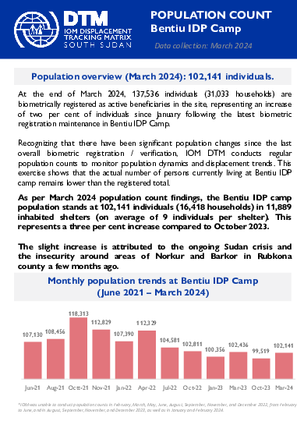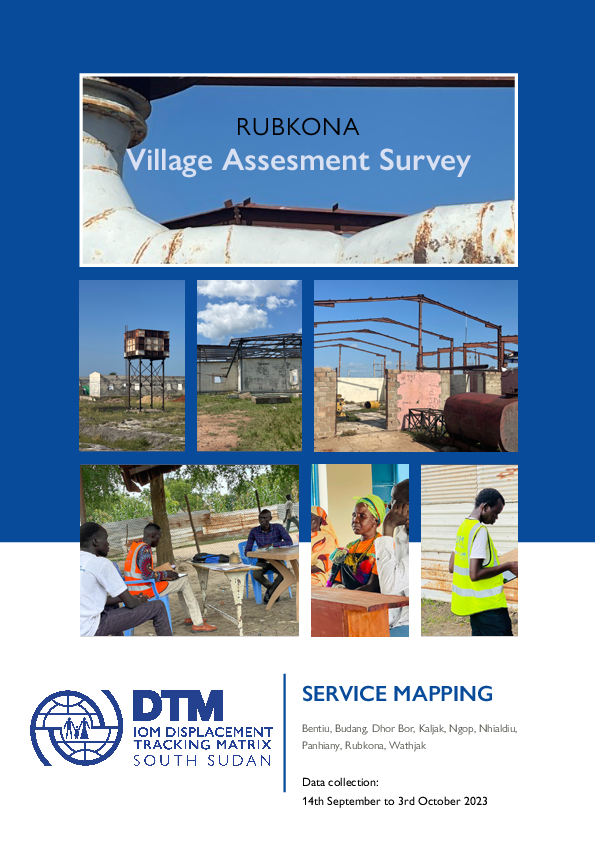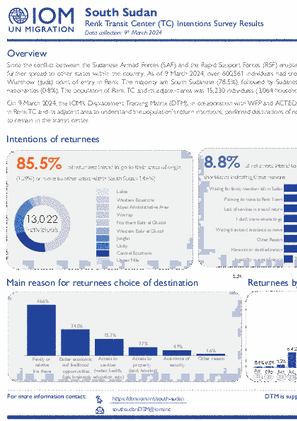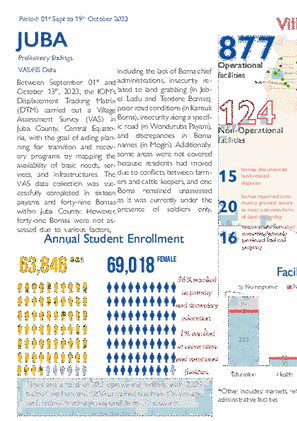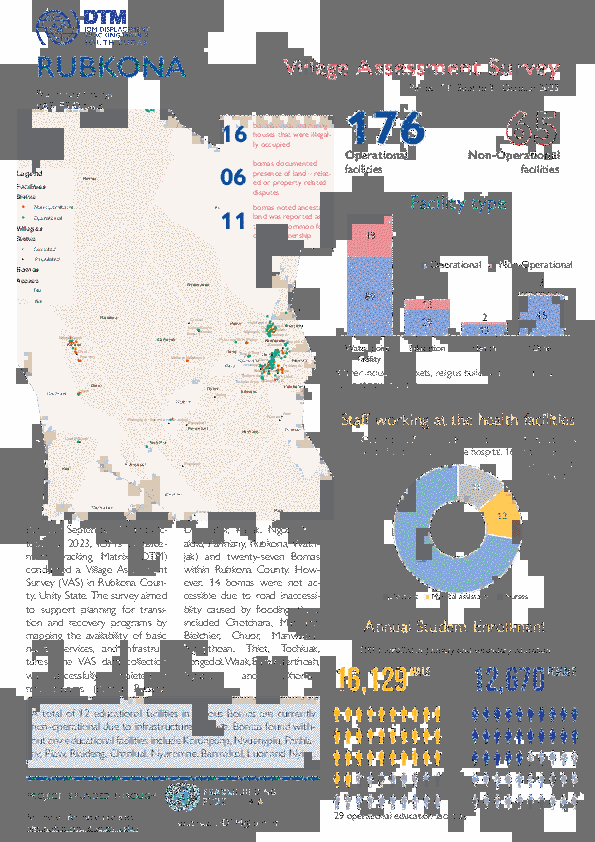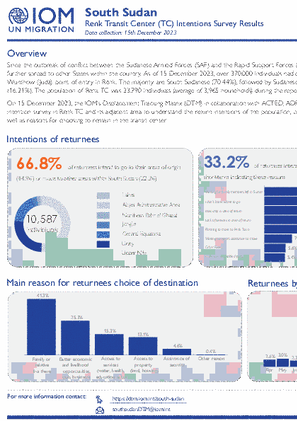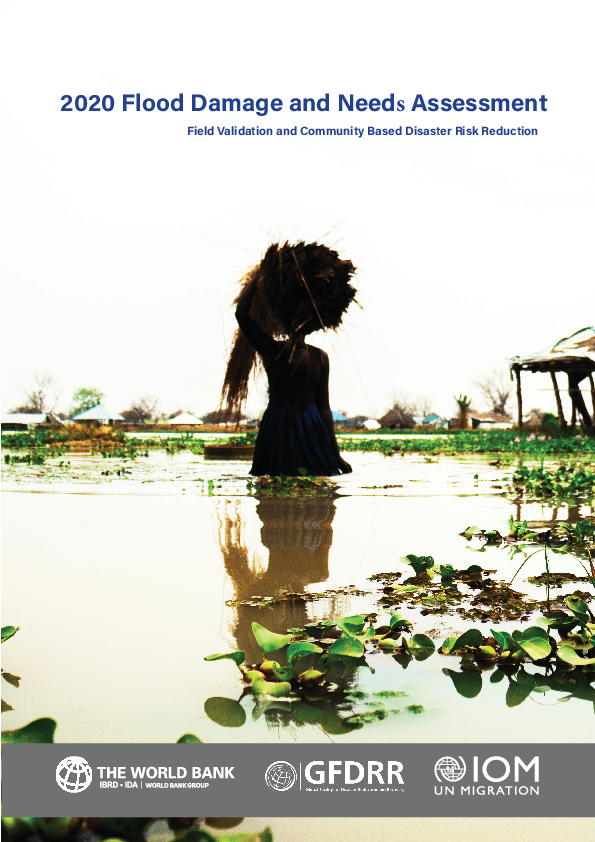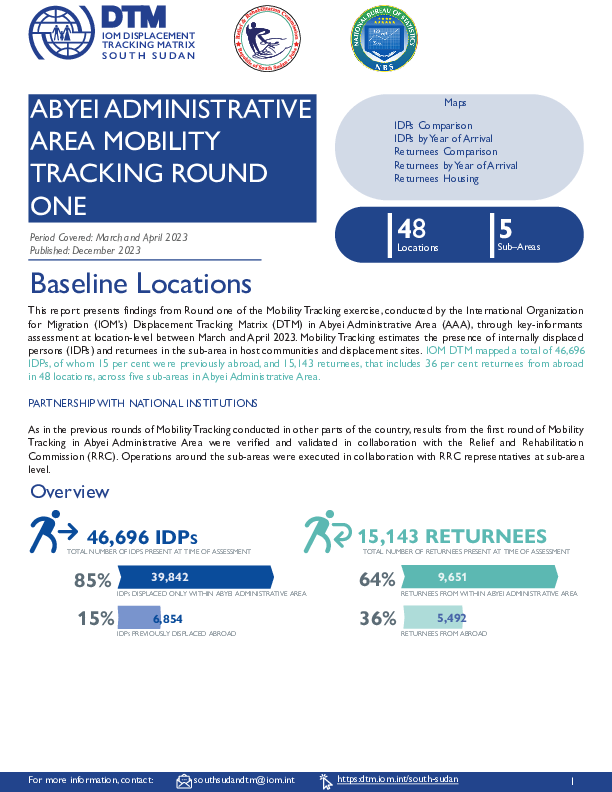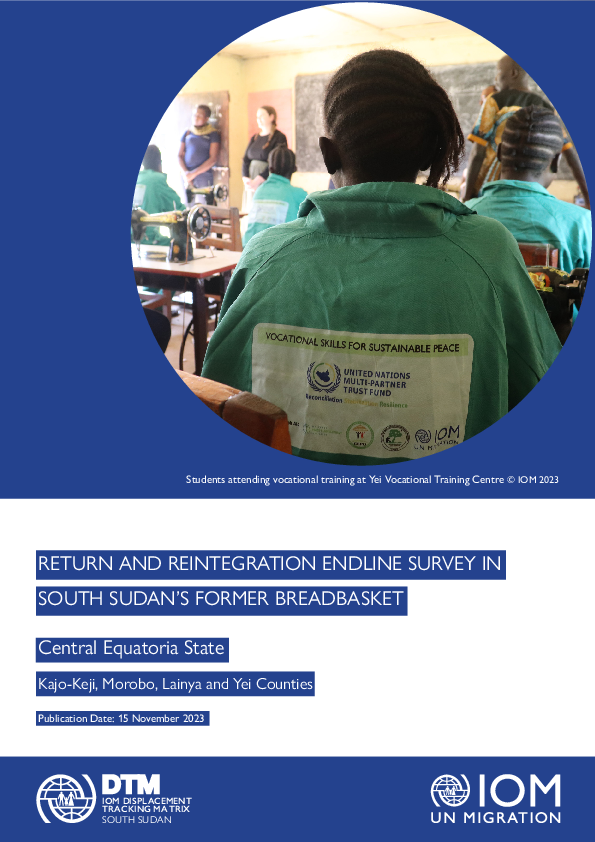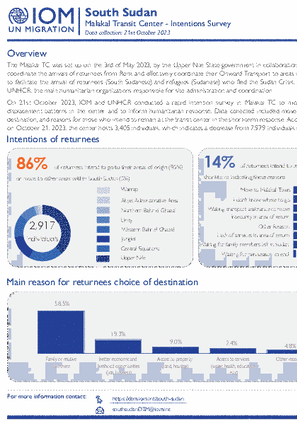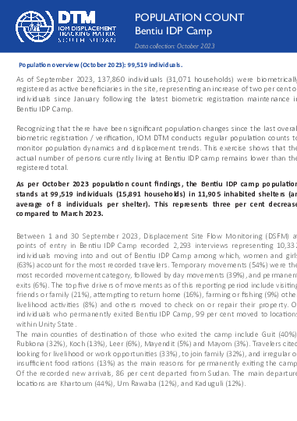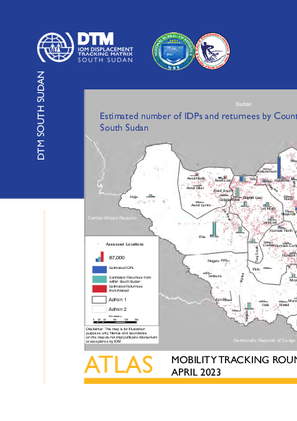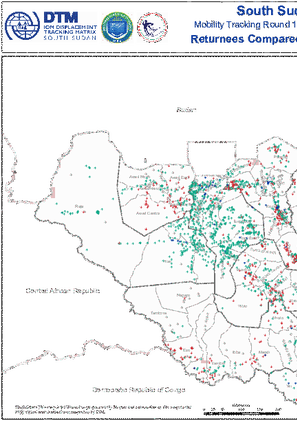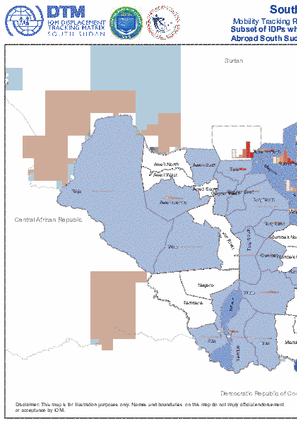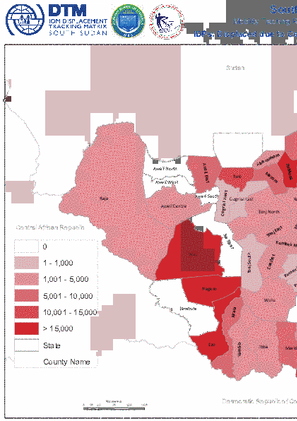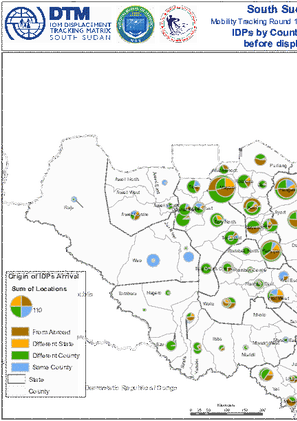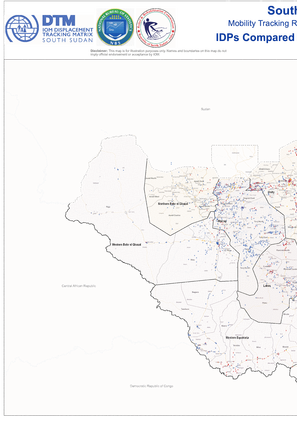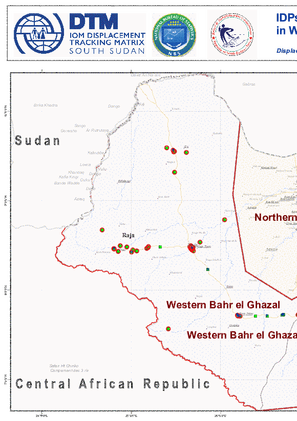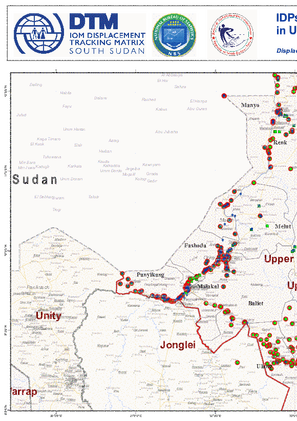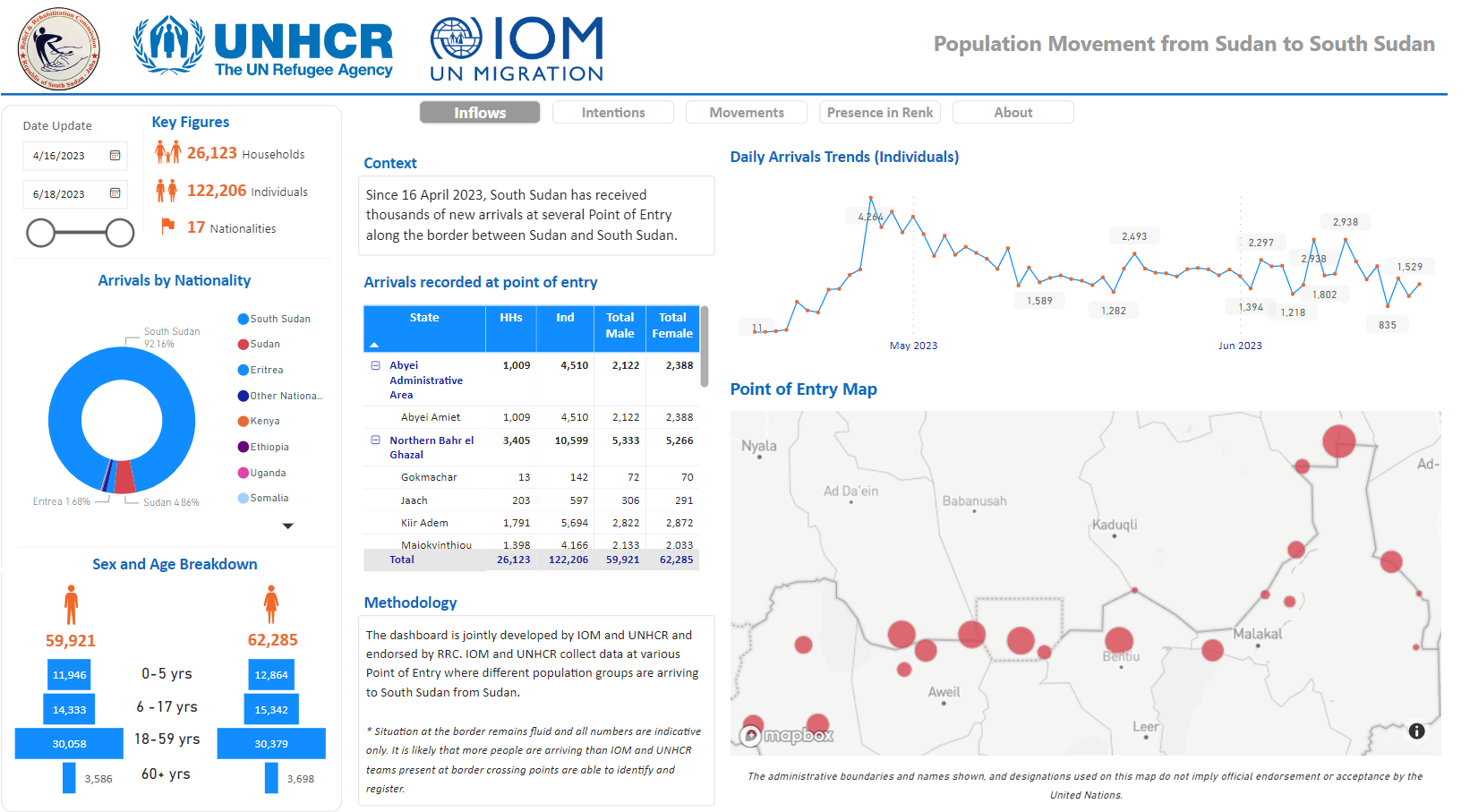-
Countries
-
Data and Analysis
-
Special Focus
-
Crisis Responses
South Sudan
South Sudan
IDPs tracked
Displacement Movements
1,121,000
IDMC 2023
Data collection round
About South Sudan
Conflict and instability in South Sudan have resulted in large-scale internal and cross-border displacement since the December 2013 crisis of over 4 million individuals. In September 2018, the Revitalized Agreement for the Resolution of the Conflict in South Sudan (R-ARCSS) was signed between the major warring parties. Whilst overall there have been improvements in security since and returns are ongoing, fighting and communal clashes (frequently linked to cattle raiding) continue to trigger new displacements and the situation remains volatile.
DTM South Sudan’s toolbox is designed to meet critical information gaps during all phases of response, from preparedness, to intervention and transition/recovery. DTM South Sudan provides country-wide figures on the numbers, locations and priority needs of IDPs and returnees updated on a quarterly and ad-hoc basis. The programme undertakes biometric registration in selected parts of the country to support partners with reaching intended beneficiaries during distributions. Flow monitoring data is collected on a daily basis at displacement sites, key transit hubs and border crossing points to identify mobility dynamics of migrants including IPDs and returnees. Through ad hoc surveys, headcounts, infrastructure/service mapping exercises and other assessments, DTM provides additional information to support partners in planning their response.
Contact
IOM South Sudan DTM Juba
ISSDTM@iom.int
Current Donors
- Switzerland
- Japan
- DFID
- ECHO
- OCHA
- OFDA
- Canada (DFATD)
- WFP
- UN Peacebuilding Fund
- World Bank
South Sudan — Village Assessment Survey, Wau (October 2023)
KEY FINDINGS 1. HOUSING AND LAND CHALLENGES Many bomas face issues related to housing, land demarcation, and property ownership, with some areas lacking demarcated settlement areas and others experiencing disputes over land boundaries, ownership and illegal occupancy.
South Sudan — Event Tracking: Report #57 (July 2024)
In South Sudan, a complex humanitarian crisis is unfolding due to various factors such as communal conflicts, land disputes, insecurity, violence, natural disasters, and displacement across borders.
South Sudan — Bentiu IDP Camp Population Count (May 2024)
At the end of May 2024, 137,536 individuals (31,033 households) are biometrically registered as active beneficiaries in the site, representing an increase of two per cent of individuals since January following the latest biometric registration maintenance in Bentiu IDP Camp.
South Sudan — Event Tracking: Report #56 (June 2024)
South Sudan is grappling with a multifaceted humanitarian crisis marked by significant internal displacements.
South Sudan — Bentiu IDP Camp Population Count (March 2024)
As per March 2024 population count findings, the Bentiu IDP camp population stands at 102,141 individuals (16,418 households) in 11,889 inhabited shelters (on average of 9 individuals per shelter). This represents a three per cent increase compared to October 2023.
South Sudan — Rubkona County Village Assessment Survey (September - October 2023)
The data collection took place from September 14th, 2023, to October 3rd, 2023, covering a period of twenty days.
South Sudan — Renk Transit Center - Intentions Survey (March 2024)
On 9 March 2024, the IOM’s Displacement Tracking Matrix (DTM), in collaboration with WFP and ACTED, conducted a rapid intention survey in Renk TC and its adjacent area to understand the population's return intentions, preferred destinations of return, as well as reasons for choosing to remain in
South Sudan — Bentiu IDP Camp Biometric Registration Services Beneficiary Satisfaction Survey (April 2024)
Between 1 and 30 April 2024, IOM’s Displacement Tracking Matrix (DTM) interviewed 1,106 households representing 7,810 household members to assess the beneficiary satisfaction among service-receiving IDPs during distributions in Bentiu IDP Camp.
South Sudan — Inter Sectoral Needs Assessment Report (ISNA) - Rural Component (July - August 2023)
The overall goal of the 2023 humanitarian Inter-Sector Needs Assessment (ISNA) was to collect and analyze data on the needs and vulnerabilities of households, displacement and migration history, shelter and non-food items (SNFI), water, sanitation and
South Sudan — Urban Inter Sectoral Needs Assessment (ISNA) - Rubkona County (September - October 2022)
Between September and October 2022, the International Organization for Migration’s Displacement Tracking Matrix (IOM DTM) undertook its third household-level multi-sector assessment of selected urban areas and camps for internally displaced persons (IDPs) in South Sudan
South Sudan — Urban Inter Sectoral Needs Assessment (ISNA) - Wau County (September - October 2022)
Between September and October 2022, the International Organization for Migration’s Displacement Tracking Matrix (IOM DTM) undertook its third household-level multi-sector assessment of selected urban areas and camps for internally displaced persons (IDPs) in South Sudan
South Sudan — Juba County Village Assessment Survey Preliminary Findings (1 September - 19 October 2023)
Between 1 September and 13 October 2023, the IOM's Displacement Tracking Matrix (DTM) carried out a Village Assessment Survey (VAS) in Juba County, Central Equatoria, with the goal of aiding planning for transition and recovery programs by mapping the availability of basic needs, services and inf
South Sudan — Wau County Village Assessment Survey- Preliminary Findings (23 September - 19 October 2023)
Between 23 September and 19 October 2023, IOM's Displacement Tracking Matrix (DTM) conducted a Village Assessment Survey (VAS) in Wau County, Western Bahr el Ghazal.
South Sudan — Rubkona County Village Assessment Survey- Preliminary Findings (14 September - 3 October 2023)
Between 14 September and 3 October 2023, IOM's Displacement Tracking Matrix (DTM) conducted a Village Assessment Survey (VAS) in Rubkona County, Unity State.
South Sudan — Renk Transit Center - Intentions Survey (January 2024)
On 27 January 2024, the IOM’s Displacement Tracking Matrix (DTM) in collaboration with WFP, ACTED, LWF, and Save the Children conducted a rapid intention survey in Renk TC and its adjacent area to understand the return intentions of the population, preferred destination
South Sudan - Renk Transit Center - Intentions Survey (December 2023)
On 15 December 2023, the IOM’s Displacement Tracking Matrix (DTM) in collaboration with ACTED, ADRA, and GOAL conducted a rapid intention survey in Renk TC and its adjacent area to understand the return intentions of the population, preferred destinations of return as well as reasons for choosing
South Sudan — Flood Damage and Needs Assessment Study (2021)
1. This report provides field-level data to complement and validate findings from the 2020 Flood Damage and Needs Assessment (FDNA) on the 2020 seasonal floods (June-December) in South Sudan which largely relied on the analysis of remote sensing and geodata.
South Sudan — Abyei Administrative Area Mobility Tracking Round 1
This summary presents initial findings from Round 1 of Mobility Tracking conducted across Abyei Administrative Area through key-informant assessments at location-level in April 2023.
South Sudan — Fragility Study Report - Understanding Multidimensional Fragility in South Sudan - 2023
This study provides a comprehensive assessment of the multiple dimensions of fragility in South Sudan at the subnational level: political and legal, social, economic, security, and environmental.
South Sudan — Return and Reintegration Endline Survey in South Sudan’s Former Breadbasket
To gain comprehensive insights into the dimensions of return and reintegration, the International Organization for Migration’s (IOM) Displacement Tracking Matrix (DTM) unit executed a targeted study within Southern Central Equatoria State, as part of the Reconcili
South Sudan — Malakal Transit Center - Intentions Survey (October 2023)
On 21st October 2023, IOM and partners (UNHCR, DRC, and ACTED) conducted a rapid intention survey in Malakal TC to monitor the population dynamics and displacement patterns in the center and to inform humanitarian response.
South Sudan — Renk Transit Center - Intentions Survey (September 2023)
On 27 September 2023, IOM and partners conducted a rapid intention survey in Renk TC and its area adjacent. The partners included ACTED, Save the Children, Mentor Initiative, Plan International, ADRA, IRC, LWF and GOAL.
South Sudan — Bentiu IDP Camp Population Count (October 2023)
As per October 2023 population count findings, the Bentiu IDP camp population stands at 99,519 individuals (15,891 households) in 11,905 inhabited shelters (an average of 8 individuals per shelter). This represents three per cent decrease compared to March 2023.
South Sudan — Mobility Tracking Round 14 Atlas (March - April 2023)
This atlas contains a summary of findings from the fourteenth round of Mobility Tracking conducted across South Sudan through key-informants based assessment at location level between March and April 2023.
Pagination
South Sudan - Event Tracking (June 2024)
2024-06-30
<p>South Sudan is grappling with a multifaceted humanitarian crisis marked by significant internal displacements. The factors fueling these displacement dynamics are diverse, encompassing communal clashes, land disputes, insecurity, violence, disasters, and cross-border movements.<br>…
South Sudan - Population Count - Bentiu IDP Camp (May 2024)
2024-05-31
<p>At the end of May 2024, 137,536 individuals (31,033 households) are biometrically registered as active beneficiaries in the site, representing an increase of two per cent of individuals since January following the latest biometric registration maintenance in Bentiu IDP Camp.</p><p…
Sudan Crisis - Returnee Reintegration & Perceptions Survey (March 7-14 2024)
2024-03-14
<p>This survey focuses on South Sudanese returnees from Sudan who received onward transportation assistance from the International Organization for Migration (IOM) in coordination with the government of South Sudan. It was conducted over the phone with individuals who stated their destination…
Sudan Crisis - Returnee Reintegration & Perceptions Survey (February 2-16 2024)
2024-02-16
<p>This survey was administered in person with returnee heads of household in Renk to understand their plans for and potential concerns about (re)integration in their intended destinations in South Sudan.</p>
Sudan Crisis - Returnee Reintegration & Perceptions Survey (January 18 - February 1 2024)
2024-02-01
<p>This survey was administered in person with returnee heads of household in Renk to understand their plans for and potential concerns about (re)integration in their intended destinations in South Sudan.</p>
South Sudan - Event Tracking (January - December 2023)
2023-12-31
<p>IOM DTM employs Event Tracking as a more rapid and localized assessment tool complementing overall efforts to report IDP and Returnee figures nationally. IOM teams access IDP/Returnee locations and consult local key informants including community representatives, local authorities or…
South Sudan — Wau County Village Assessment Survey (23 September - 19 October 2023)
2023-10-19
<p>Between 23 September and 19 October 2023, IOM's Displacement Tracking Matrix (DTM) conducted a Village Assessment Survey (VAS) in Wau County, Western Bahr el Ghazal. The Survey aims to support planning for transition and recovery programs by mapping the availability of basic needs,…
South Sudan — Juba County Village Assessment Survey (1 September - 19 October 2023)
2023-10-19
<p>Between 1 September and 13 October 2023, the IOM's Displacement Tracking Matrix (DTM) carried out a Village Assessment Survey (VAS) in Juba County, Central Equatoria, with the goal of aiding planning for transition and recovery programs by mapping the availability of basic needs,…
South Sudan — Rubkona County Village Assessment Survey (14 September - 3 October 2023)
2023-10-03
<p>Between 14 September and 3 October 2023, IOM's Displacement Tracking Matrix (DTM) conducted a Village Assessment Survey (VAS) in Rubkona County, Unity State. The survey aims to support planning for transition and recovery programs by mapping the availability of basic needs, services,…
South Sudan — Flow Monitoring Registry — April - June 2023
2023-06-30
Flow monitoring aims to derive quantitative estimates of the flow of individuals through specific locations and to collect information about the profile, intentions and needs of the people moving and to quantify highly mobile populations by providing a picture of complex mobility dynamics.
South Sudan - Baseline Assessment Round 14
2023-04-30
A baseline assessment is a sub-component of mobility tracking. It aims to collect data on IDP, migrant or returnee population presence in a defined administrative area of the country.
South Sudan - Baseline Locations Round 14
2023-04-30
<p>A baseline assessment is a sub-component of mobility tracking. It aims to collect data on IDP, migrant or returnee population presence in a defined administrative area of the country.</p>
South Sudan — Flow Monitoring Registry — January - March 2023
2023-03-31
Flow monitoring aims to derive quantitative estimates of the flow of individuals through specific locations and to collect information about the profile, intentions and needs of the people moving and to quantify highly mobile populations by providing a picture of complex mobility dynamics.
South Sudan - Event Tracking (January - December 2022)
2022-12-31
<p>IOM DTM employs Event Tracking as a more rapid and localized assessment tool complementing overall efforts to report on IDP and returnee figures nationally. IOM teams access IDP/returnee locations and consult local key informants including community representatives, local authorities or…
South Sudan — Flow Monitoring Registry — January - October 2022
2022-10-31
Flow monitoring aims to derive quantitative estimates of the flow of individuals through specific locations and to collect information about the profile, intentions and needs of the people moving and to quantify highly mobile populations by providing a picture of complex mobility dynamics.
South Sudan - Baseline Assessment Round 13
2022-08-31
Mobility Tracking quantifies the presence of internally displaced persons (IDPs) and returnees in South Sudan in displacement sites and host communities. As of August 2022, IOM DTM mapped a total of 2,257,672 IDPs (of whom, 7% previously displaced abroad) and 2,175,352 returnees (29% from abroad)…
South Sudan - Baseline Locations Round 13
2022-08-31
Mobility Tracking quantifies the presence of internally displaced persons (IDPs) and returnees in South Sudan in displacement sites and host communities. As of August 2022, IOM DTM mapped a total of 2,257,672 IDPs (of whom, 7% previously displaced abroad) and 2,175,352 returnees (29% from abroad)…
South Sudan — Flow Monitoring Registry — February 2022
2022-02-28
Flow monitoring aims to derive quantitative estimates of the flow of individuals through specific locations and to collect information about the profile, intentions and needs of the people moving and to quantify highly mobile populations by providing a picture of complex mobility dynamics.
South Sudan — Flow Monitoring Registry — January 2022
2022-01-31
Flow monitoring aims to derive quantitative estimates of the flow of individuals through specific locations and to collect information about the profile, intentions and needs of the people moving and to quantify highly mobile populations by providing a picture of complex mobility dynamics.
South Sudan — Flow Monitoring Registry — December 2021
2021-12-31
Flow monitoring aims to derive quantitative estimates of the flow of individuals through specific locations and to collect information about the profile, intentions and needs of the people moving and to quantify highly mobile populations by providing a picture of complex mobility dynamics.






